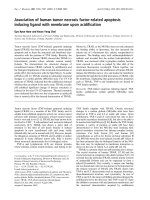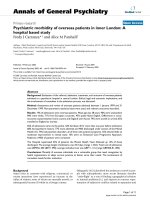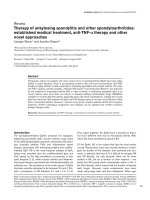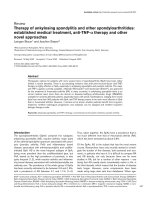Báo cáo y học: " Improvement of platelet dysfunction in chronic myelogenous leukemia following treatment with imatinib: a case report" pps
Bạn đang xem bản rút gọn của tài liệu. Xem và tải ngay bản đầy đủ của tài liệu tại đây (300.21 KB, 4 trang )
CAS E REP O R T Open Access
Improvement of platelet dysfunction in chronic
myelogenous leukemia following treatment
with imatinib: a case report
Alexander Shimabukuro-Vornhagen, Achim Rothe, Lucia Nogova, Matthias Kochanek, Christoph Scheid and
Michael von Bergwelt-Baildon
*
Abstract
Introduction: In patients with chronic myeloid leukemia, tyrosine kinase inhibitors suppress the BCR-ABL
+
clone
and often induce complete molecular remissions. Megakaryocytes in such patients have been shown to be derived
from the BCR-ABL
+
clone, and abnormal platelet function is frequent in chronic myeloid leukemia. However, little is
known about the influence of modern targeted therapy on chronic myeloid leukemia-associated platelet disorders.
Case presentation: We report the case of a massive hemorrhage in a 32-year-old Caucasian man caused by
chronic myeloid leukemia-associated platelet dysfunction, which improved after treatment with imatinib.
Conclusion: This report demonstrates that platelet dysfunction and bleeding disorder in BCR-ABL
+
chronic myeloid
leukemia can successfully be treated with imatinib. We suggest the monitoring of platelet function in future
studies using imatinib to treat patients with chronic myeloid leukemia.
Introduction
Chronic myeloid leukemia (CML) is a clonal myeloproli-
ferative disorder that results from the malignant
transformation of a hematopoietic stem cell. It is char-
acterized by the Philadelphia chromosome (Ph), which
is formed by translocation and fusion of the long arms
of chromosomes 9 and 22 in a pluripotent hematopoie-
tic progenitor cell. At the molecular level, the fusion
generates a BCR-ABL protein with constitutive tyrosine
kinase activity. Tyrosine kinase inhibitors such as imati-
nib are able to suppress the BCR-ABL
+
clone and induce
molecular remission. Megakaryocytes are thought to
belong to the BCR-ABL
+
clone, and abnormal platelet
function has been described in CML. However, little is
known about the influence of modern targeted therapy
on CML-associ ated platelet disorders. W e report
the case of a massive hemorrhage caused by CML-
associated platelet dysfunction which improved a fter
treatment with imatinib.
Case presentation
A 32-year-old Caucasian man consulted his primary
care physician because of left upper-quadrant abdominal
pain, dyspnea upon exertion, d renching night sweats,
and unintentional weight loss. His initial clinical
examination revealed tachycardia of 120 beats/minute,
pronounced pallor, and splenomegaly of 8 cm×26 cm.
Laboratory analysis showed a leukocyte count of
327×10
9
/L, a hemoglobin level of 7.0 g/dL, and a plate-
let count of 377×10
9
/μL. The patient’ s lactate dehydro-
genase level was significantly elevated at 1080 IU/L . His
coagulation tests showed a normal activated partial
thromboplastin time (aPTT) of 34 seconds (< 36
seconds) and an international normali zed ratio (INR) of
1.1. The patient was taking no medications.
He was immediately referred to our Department of
HematologyandOncology.Thereabonemarrow
aspiration was performed, and cytomorphologic a s well
as cytogenetic analysis was carried out. Microscopic
examination showed a left-shifted granulopoiesis with
8% blasts and 20% promyelocytes. The alkaline phospha-
tase index was 2. A BCR-ABL fusion transcript (coeffi-
cient 26.074 = 100×bcr-abl/abl) could be identified by
* Correspondence:
Department I of Internal Medicine, University Hospital Cologne, Kerpener
Strasse 62, D-50924 Köln, Germany
Shimabukuro-Vornhagen et al. Journal of Medical Case Reports 2011, 5:215
/>JOURNAL OF MEDICAL
CASE REPORTS
© 2011 Shimabukuro-Vornhagen et al; licensee BioMed Central Ltd. This is an Op en Access article distr ibuted under the terms of the
Creative Commons Attribution Li cense ( which permits unrestricted use, distribution, and
reproduction in any medium, provided the original work is properly cited.
polymerase chain reaction assay. Thus, the diagnosis of
aPh
+
CML in chronic phase was made.
The patient initially underwent leukapheresis twice
and then received cytoreductive chemotherapy with
hydroxyurea. Simultaneously, the search for a bone
marrow donor was initiated. After 14 days, n ormal
leukocyte counts were reached and the therapeutic regi-
men was switched to the tyrosine kinase inhibitor imati-
nib. While the initial management efficiently led to a
reduction of CML blasts, the patient encountered a
severe complicati on of a standard diagnostic procedure:
three days after bone marrow aspiration at the left
super ior posterior iliac spine he complained about mas-
sive pain in his left buttock. A clinical examination
revealed massive swelling that was extremely tender to
touch. The increasing pain necessitated the use of con-
tinuous intravenous morphine. Computed tomography
revealed a large hematoma in the left gluteal region.
One day after the onset of symptoms surgery became
necessary because of increasing swelling accompanied
by a drop of the hemoglobin and impending compart-
ment syndrome. During surgery, diffuse bleeding was
noted without an identifiable lesion to major vessels or
other anatomic structures. The hematoma (about 500
mL) was evacuated, and fresh frozen plasma (FFP) as
well as packed red blood cells (PRBCs) were given to
the patient. At the time of surgery, PTT was 40
seconds, the INR was 1.4, and the platelet count was
300×10
9
/L. Th e patient’ s post-operative course was
complicated by continuous bleeding with a further
increase in size of the hematoma and extens ion into the
left leg, renewed dete rioration of coagula tion para-
meters, and onset of fever (< 38.5°C). Continuous sub-
stitution of FFP and PRBCs was nec essary, and surgery
had to be repeated on day 9. Because of continuous
post-operative bleeding and the risk of compartment
syndrome, the woun d was left open to reduce tissue
pressure. The bleeding time assessed according to the
modified template method was prolonged at 13 minutes.
Therefore, further platelet function tests were
performed. Occlusion times determined by using a pla-
telet function analyzer (PFA-100; Dade Behring, Inc.,
Deerfield, IL, USA) were 152 seconds for adenosine
diphosphate (ADP) (71 to 118 seconds) and > 300
seconds for collagen/epinephrine (C/Epi) (94 to 193
seconds), respectively. As the patient had no history of
bleeding prior to the diagnosis of CML, further labora-
tory examinations for other pathological bleeding
situations were not performed. Therefore, despite
increased platelet counts, platel et transfusions were
initiated. Following the platelet substitution, his bleeding
ceased quickly. The patient could be discharged 10 days
later. At that time, the patient had paresis of the leg
with a positive Trendelenburg’s sign due to compression
of the superior gluteal nerve. His bl eeding time was sti ll
highly pathologic upon discharge.
We assumed that the patient’s platelet dysfunction
originated from a clonal expansion of dysfunctional
megakaryocytes derived from the identical stem cell
from which the CML blasts had o riginated. We there-
fore hypothesized that treatment targeting BCR-ABL
would be equally effective in reducing the CML blasts
and dysfunctional megakaryocytes. Despite the risk of
hemorrhage in this patient, we therefore continued a
single-agent treatment strategy with imatinib in an o ut-
patient setting.
No further episodes of bleeding occurred during the
follow-up of the patient. During that time, the patient
underwent dental surgery without experiencing exces-
sive bleeding. The defect in the gluteal region disap-
peared completely as a result of secondary w ound
healing, and the paresis regressed steadily. Six months
after discharge from the hospital the patient was in
excellent health. At his last complete laboratory follow-
up four years later, his bleeding time was normal (four
minutes) and his C/Epi occlusion time was 211 (94 to
193 seconds). He was in complete molecular remission.
Six years after the incident the patient remains clinically
in very good health without any signs of bleeding and
continues to be in complete molecular remission.
Discussion
The pathologic changes in CML affect not only CML
blasts but also other hematopoietic lineages, which adds
to the array of clinical manifestations and increases
morbidity as well as mortality of the disease [1-4].
Bleeding is a frequent complication in patients with
myeloproliferative disorders, including CML, and quali-
tative platelet abnorm alities are frequently observed [5].
Thrombocytosis is observed in about one of three
patients, and platelet dysfunction occurs in one of six
patients. Platelet dysfunction in chronic myeloprolifera-
tive disorders is multi-factorial [6]. One of the most
characteristic platelet defects in myeloproliferative
disorders is a reduced responsiveness to epinephrine,
while the response to ADP usually is intact. This was
found to be due to a reduction in a-adrenergic recep-
tors on the platelet membrane. The cause of the
decreased surface expression of a-adrenergic receptors
is unknown, though.
Molecularly, BCR-ABL rearrangements have clearly
been demonstrated in megakaryocytic cell lines as well
as in megakaryocytes from the vast majority of CML
patients [1,3,4,7]. Therapeutic a pproaches in Ph
+
CML
to reduce the number of CML blasts previously had
proven effective in reducing the number of BCR-ABL
+
megakaryocytes [3,7]. Furthermore, previous studies in
which imatinib was used to treat patients with CML
Shimabukuro-Vornhagen et al. Journal of Medical Case Reports 2011, 5:215
/>Page 2 of 4
confirmed in vitro effects on o ther BCR-ABL
+
subp opu-
lations. Importantly, bone marrow biopsies in these
patients demonstrated an inhibitory effect of imatinib
on increased megakaryopoeisis [8]. Also, Thiele et al.[9]
found that the atypical micromegakaryocytes that are
prevalent in Ph
+
CML were significantly reduced after
imatin ib therapy with a further reappearance of normal-
sized megakaryocytes.
The study by Nolte et al. [10] showed that not only
the transforming event but also the Ph
+
translocation
leading to BCR-ABL
+
fusion happens prior to the
differentiation of the pluripotent stem c ell into different
myeloid lineages.
In vitro studiesdonebyEra[11]andBuetet al. [12]
showed two novel aspects of the differentiation of hema-
topoietic stem cells. Era demonstrated that enforced
BCR-ABL
+
expression was sufficient to increase the
number of both multi-lineage progenitors and myeloid
progenitors. Buet et al. showed that alteration of signal
transduction via BC R- ABL
+
reprograms megakaryocyte
cells into erythroi d cells by down-regulation of FLI-1.
This suggests that BCR-ABL
+
represents a “ molecular
switch” for the decision for growth and differentiation in
hematopoietic stem cells in general [12].
On the basis of the high frequency of megakaryocyte
involvement in CML patients and the concurrent
thrombocytosis in our patient, we assu med that platelet
dysfunction was a manifestation of CML and that the
megakaryocytes also carried the BCR-ABL fusion gene.
Interestingly, in our patient, the achievement of
complete molecular remission was parallele d by a signif-
icant improvement in platelet dysfunction (Figure 1).
This was reflected in normalization of bleeding time, a
decrease in C/Epi from > 300 seconds to 211 seconds,
and successful dental surgery without bleeding
complications.
Because of the patient’s clinical course and his reluc-
tance, we decided not to perform another bone marrow
biopsy to confirm BCR -ABL fusion transcripts in his
megakaryocytes.
Conclusion
Toourknowledge,thisisthefirstreporttoshowthat
platelet dysfunct ion and bleeding disorder in BCR-ABL
+
CML can be treated successfully with imatinib. To val i-
date these observat ions, we strongly suggest monitoring
platelet function in future studies using imatinib or sec-
ond-generation tyrosine kinase inhibitors, such as
Figure 1 Time course of platelet counts, leukocyte counts, quantitative polymerase chain reaction for BCR-ABL (expressed as log
reduction from baseline), and platelet function analyzer PFA-100 platelet function tests.
Shimabukuro-Vornhagen et al. Journal of Medical Case Reports 2011, 5:215
/>Page 3 of 4
dasatinib, in patients with CML. We emphasize the need
for further research to validate our clinical observations.
Consent
Written informed consent was obtained from the patient
for publication of this case report and any accompanying
images. A copy of the written consent is available for
review by the Editor-in-Chief of this journal.
Authors’ contributions
ASV wrote the case report. AR contributed to the writing of the case report.
LN, MK, and CS analyzed and interpreted the patient data regarding the
hematological disease. MvBB analyzed and interpreted the patient data
regarding the hematological disease and contributed to the writing and
revision of the manuscript. All authors read and approved the final
manuscript.
Competing interests
The authors declare that they have no competing interests.
Received: 12 September 2010 Accepted: 30 May 2011
Published: 30 May 2011
References
Inokuchi K, Nomura T (1993) The relationship between the type of bcr-abl hybrid
messenger RNA and thrombopoiesis in Philadelphia-positive chronic
myelogenous leukemia. Leuk Lymphoma 10:9–15
Maguer-Satta V, Petzer AL, Eaves AC, Eaves CJ (1996) BCR-ABL expression in
different subpopulations of functionally characterized Ph
+
CD34
+
cells from
patients with chronic myeloid leukemia. Blood 88:1796–1804
Thiele J, Schmitz B, Fuchs R, Kvasnicka HM, Lorenzen J, Fischer R (1998)
Detection of the bcr/abl gene in bone marrow macrophages in CML and
alterations during interferon therapy: a fluorescence in situ hybridization
study on trephine biopsies. J Pathol 186:331–335. doi:10.1002/(SICI)1096-9896
(199811)186:33.0.CO;2-7.
Perego RA, Costantini M, Cornacchini G, Gargantini L, Bianchi C, Pungolino E,
Rovida E, Morra E (2000) The possible influences of B2A2 and B3A2 BCR/ABL
protein structure on thrombopoiesis in chronic myeloid leukaemia. Eur J
Cancer 36:1395–1401. doi:10.1016/S0959-8049(00)00128-3.
Savage DG, Szydlo RM, Goldman JM (1997) Clinical features at diagnosis in 430
patients with chronic myeloid leukaemia seen at a referral centre over a 16-
year period. Br J Haematol 96:111–116. doi:10.1046/j.1365-2141.1997.d01-
1982.x.
Schafer AI (1984) Bleeding and thrombosis in the myeloproliferative disorders.
Blood 64:1–12
Thiele J, Schmitz B, Gross H, Kvasnicka HM, Niederle N, Leder LD, Fischer R (1997)
Fluorescence in-situ hybridization (FISH) reveals that in chronic myelogenous
leukaemia (CML) following interferon-α therapy, normalization of
megakaryocyte size is associated with the loss of bcr/abl translocation.
Histopathology 31:215–221. doi:10.1046/j.1365-2559.1997.2480853.x.
Beham-Schmid C, Apfelbeck U, Sill H, Tsybrovsky O, Höfler G, Haas OA,
Linkesch W (2002) Treatment of chronic myelogenous leukemia with the
tyrosine kinase inhibitor STI571 results in marked regression of bone marrow
fibrosis. Blood 99:381–383. doi:10.1182/blood.V99.1.381.
Thiele J, Kvasnicka HM, Varus E, Ollig E, Schmitt-Graeff A, Staib P,
Griesshammer M (2004) Megakaryocyte features and bcr/abl translocation in
chronic myeloid leukemia following imatinib mesylate (STI571) therapy: a
fluorescence in-situ hybridization study. Leuk Lymphoma 45:1627–1631.
doi:10.1080/10428190410001683732.
Nolte M, Werner M, Ewig M, von Wasielewski R, Link H, Diedrich H, Georgii A
(1996) Megakaryocytes carry the fused bcr-abl gene in chronic myeloid
leukaemia: a fluorescence in situ hybridization analysis from bone marrow
biopsies. Virchows Arch 427:561–565
Era T (2002) Bcr-Abl is a “molecular switch” for the decision for growth and
differentiation in hematopoietic stem cells. Int J Hematol 76:35–43.
doi:10.1007/BF02982716.
Buet D, Raslova H, Geay JF, Jarrier P, Lazar V, Turhan A, Morlé F, Vainchenker W,
Louache F (2007) p210
BCR-ABL
reprograms transformed and normal human
megakaryocytic progenitor cells into erythroid cells and suppresses FLI-1
transcription: megakaryocytic to erythroid reprogramming by p210
BCR-ABL
.
Leukemia 21:917–925
doi:10.1186/1752-1947-5-215
Cite this article as: Shimabukuro-Vornhagen et al.: Improvement of
platelet dysfunction in chronic myelogenous leukemia following
treatment with imatinib: a case report. Journal of Medical Case Reports
2011 5:215.
Submit your next manuscript to BioMed Central
and take full advantage of:
• Convenient online submission
• Thorough peer review
• No space constraints or color figure charges
• Immediate publication on acceptance
• Inclusion in PubMed, CAS, Scopus and Google Scholar
• Research which is freely available for redistribution
Submit your manuscript at
www.biomedcentral.com/submit
Shimabukuro-Vornhagen et al. Journal of Medical Case Reports 2011, 5:215
/>Page 4 of 4









